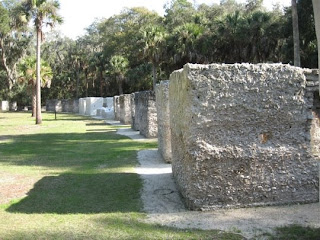


Within the Timucuan Preserve on the northern edge of Jacksonville, Florida, an immense cluster (more than 98,000 acres altogether) of preserved natural and historical sites, stands a well-preserved former sea island cotton plantation with some surprises in its history. Kingsley Plantation nestles beside extensive salt marshes and passages out to the sea and to navigable rivers. In fact, ships from England could follow waterways straight to Kingsley's dock to deliver goods and load precious sea island cotton for the voyage back.
This free attraction, run by the National Park service, is accessible by road, boat, canoe, or kayak. The house and kitchen buildings (currently closed for renovation) are smaller and simpler than some of the grand old plantations you may have visited in places like Virginia. But, like those Virginians, Kingsley's owners owed their prosperity to the slave labor of countless individuals. In one of the photos, you can see the remains of slave cabins (24 of the original 32 are visible, arranged in a semi-circle) that were built of tabby. Tabby is a concrete material made of sand, water, and lime extracted from shells, mixed with whole shells and pieces, which was widely used for building in the coastal South. Another photo shows the critter that calmly snuffled nearby while my brother and I explored the cabin ruins, barn, and other exhibits on a bright January day.
Although it's tempting to write about this plantation at length, I'll spare you that. You can find extensive information on-line if you are interested (ditto for the Timucuan Preserve). However, the history of this plantation has a couple of unusual aspects I'll mention. When Zephaniah Kingsley acquired the land, he brought his wife Anna and their children along--not so amazing, except that Anna, who was a native of Senegal in West Africa, had been his slave at one time. Further, given that Zephaniah liked owning land better than managing it, or even living there full-time, Anna eventually came to manage the plantation on her own--an unusual achievement for that time, to say the least. Unlike many of the large plantations in other areas, in which overseers drove so-called "gangs" of slaves in the fields every moment of daylight, Kingsley employed the "task" system of work under Anna's management. Individual slaves were assigned a daily task and were free to rejoin their babies, till their own gardens, etc. once they had completed the task. This is not to suggest that their lives were easy, but it does seem marginally more humane than driving people to work every daylight hour.
This post is slightly revised from my April 26. 2009 post (I have to say that this year's January was rather thin on bright, warm days like the one pictured here :>). We revisited Kingsley Plantation earlier this month with friends visiting us from Pennsylvania and enjoyed it just as much. Unfortunately, funding limitations have slowed work, and the house and kitchen building are still under renovation. They seem to be nearing completion, so we hope that we can see them later this year restored to the way they looked in Anna Kingsley's time. Next post, I'll show you some photos from this recent visit that may become paintings at some time.
Question of the day: If you were a local tourist guide, where would you take visitors and what would you want them to understand about your home area?





















Mary, what a fascinating story - and a nice surprise to see an armadillo snuffling around this historical landmark. I wonder if he had traveled up from Texas for a tour. : )
ReplyDeletethanks for your comments on the bloggy and my Coronado Island art show. It was fun but these art shows are a lot of work!!!!
take care!
Thank you, Nancy--the story of Anna Kingsley is particularly interesting to me. Many people are surprised that we have armadillos in Florida (the nine-banded kind); they putter around our neighborhood, too, and dig up grubs in the woodsy area behind our house. Great to hear from you.
ReplyDeleteIsn't it wonderful that thoughtful people and our governments have preserved a bit of our history for us to enjoy?
ReplyDeleteAnd I loved that armadillo... Can't imagine seeing one just trotting by right next to me...
Historical preservation is wonderful, Marian--Kingsley is a special jewel. And yes, armadillos do live in this area; we sometimes see them in our neighborhood, too. I don't think Northeast Florida has large numbers of them, though.
ReplyDelete